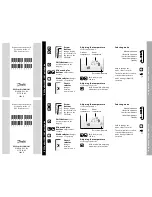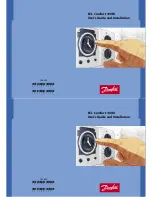
5-46
M60 MOTOR PROTECTION SYSTEM – INSTRUCTION MANUAL
PRODUCT SETUP
CHAPTER 5: SETTINGS
5
For any changes to this setting to take effect, restart the unit.
PRT2 PRP MCST ADDR
— This setting allows the user to change the multicast address used by the PRP supervision frames.
This setting is available if
REDUNDANCY
is set to PRP. All devices in the same PRP network need to have the same multicast
address. Choose an address that does not conflict with another multicast protocol.
5.3.5.5 Far-End Fault Indication (FEFI)
Since 100BASE-FX does not support Auto-Negotiation, a Far-End Fault Indication (FEFI) feature is included since UR 7 that
allows for detection of link failures.
The purpose of the Far-End Fault feature is to allow the stations on both ends of a pair of fibers to be informed when there
is a problem with one of the fibers. Without the Far-End Fault feature, it is impossible for a fiber interface to detect a
problem that affects only its transmit fiber.
When the Far-End Fault feature is supported, a loss of receive signal (link) causes the transmitter to generate a Far-End
Fault pattern in order to inform the device at the far end of the fiber pair that a fault has occurred.
When the local receiver again detects a signal, the local transmitter automatically returns to normal operation.
If a Far-End Fault pattern is received by a fiber interface that supports the Far-End Fault feature and it is enabled, it reacts
by dropping the link as if there were no signal at all.
If the receiving interface does not support the Far-End Fault feature or has it disabled, an incoming Far-End Fault pattern is
ignored.
It is strongly recommended to have switches used for substation automation that support the Far-End Fault feature,
especially when UR 7 redundancy Failover is selected for redundancy.
5.3.5.6 Parallel Redundancy Protocol (PRP)
The Parallel Redundancy Protocol (PRP) defines a redundancy protocol for high availability in substation automation
networks. It applies to networks based on Ethernet technology (ISO/IEC 8802-3) and is based on the second edition (July
2012) of IEC 62439-3, clause 4.
PRP is designed to provide seamless recovery in case of a single failure in the network, by using a combination of LAN
duplication and frame duplication. Identical frames are sent on two completely independent networks that connect source
and destination. Under normal circumstances both frames reach the destination and one of them is sent up the OSI stack
to the destination application, while the second one is discarded. If an error occurs in one of the networks and traffic is
prevented from flowing on that path, connectivity is provided through the other network to ensure continuous
communication. Take care when designing the two LANs, so that no single point of failure (such as a common power
supply) is encountered, as such scenarios can bring down both LANs simultaneously.
Figure 5-16: Example of parallel redundant network
The M60 is provided with optional PRP capability. This feature is specified as a software option at the time of
ordering. See the Order Codes section in chapter 2 for details.
Summary of Contents for M60
Page 9: ...TABLE OF CONTENTS M60 MOTOR PROTECTION SYSTEM INSTRUCTION MANUAL ix INDEX ...
Page 10: ...x M60 MOTOR PROTECTION SYSTEM INSTRUCTION MANUAL TABLE OF CONTENTS ...
Page 552: ...5 344 M60 MOTOR PROTECTION SYSTEM INSTRUCTION MANUAL TESTING CHAPTER 5 SETTINGS 5 ...
Page 660: ...iv M60 MOTOR PROTECTION SYSTEM INSTRUCTION MANUAL ABBREVIATIONS ...
















































